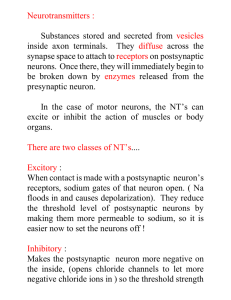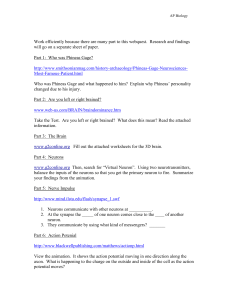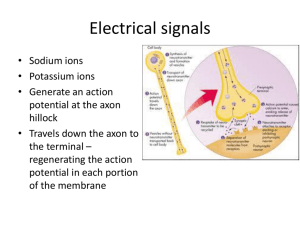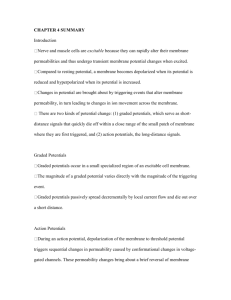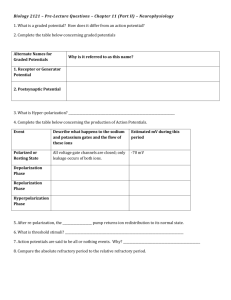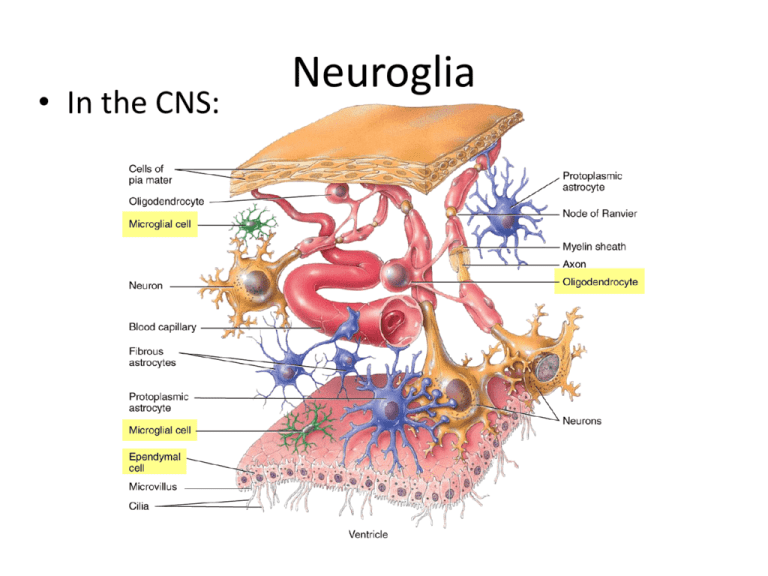
• In the CNS:
Neuroglia
• In the PNS:
Neuroglia
Neuroglia
• Myelination is the process of forming a myelin
sheath
which insulates and increases nerve impulse speed.
–It is formed by
Oligodendrocytes
in the CNS and by
Schwann cells in
the PNS.
•
Neuroglia
Nodes of Ranvier are the gaps in the myelin sheath.
– Each Schwann cell wraps one axon segment between two
nodes of Ranvier. Myelinated nodes are about 1 mm in length
and have up to 100 layers.
• The amount of myelin increases from birth
to maturity, and its presence greatly increases
the speed of nerve conduction.
– Diseases like Multiple Sclerosis
result from autoimmune
destruction of myelin.
The
Neuronal Regeneration
cell bodies of neurons lose their mitotic features at birth and
can only be repaired through regeneration after an injury (they
are never replaced by daughter cells as occurs with epithelial
tissues.)
• Nerve tissue regeneration
is largely dependent on
the Schwann cells in the
PNS and essentially doesn’t
occur at all in the CNS where
astrocytes just form scar tissue.
Neuronal Regeneration
• The outer nucleated cytoplasmic layer of the
Schwann cell, which encloses the myelin sheath,
is the neurolemma (sheath of Schwann).
– When an axon is injured, the neurolemma aids
regeneration by forming a regeneration tube that
guides and stimulates
regrowth of
the axon.
Neuronal Regeneration
• To do any regeneration, neurons must be located in
the PNS, have an intact cell body, and be
myelinated by functional Schwann cells having a
neurolemma.
– Demyelination refers to the loss or destruction of
myelin sheaths around axons. It may result from
disease, or from medical treatments such as radiation
therapy and chemotherapy.
• Any single episode of demyelination may cause deterioration
of affected nerves.
Gray and White Matter
• White matter of the brain and spinal cord is formed from
aggregations of myelinated axons from many neurons.
– The lipid part of myelin imparts the white appearance.
• Gray matter (gray because it lacks myelin) of the brain
and spinal cord is formed from neuronal cell bodies
and dendrites.
Electrical Signals in Neurons
• Like muscle fibers, neurons are electrically
excitable. They communicate with one another
using two types of electrical signals:
– Graded potentials are used
for short-distance
communication only.
– Action potentials allow
communication over long
distances within the body.
Electrical Signals in Neurons
• Producing electrical signals in neurons depends
on the existence of a resting membrane
potential (RMP) - similar to the electrical
potential of this 9 v battery which has a
gradient of 9 volts from one terminal to another.
– A cell’s RMP is created using ion gradients and a
variety of ion channels that open or close in response
to specific stimuli.
– Because the lipid bilayer of the plasma membrane is a
good insulator, ions must flow through these
channels.
•
Electrical
Signals
in
Neurons
Ion channels are present in the plasma
membrane of all cells in the body, but they are
an especially prominent component of the
nervous system.
• Much of the energy expended by neurons, and
really all cells of the body, is used to
create a net negative
charge in the inside of the
cell as compared to the
outside of the cell.
A cell’s RMP is created using ion channels
to set-up transmembrane ion gradients.
•
Electrical
Signals
in
Neurons
When ion channels are open, they allow specific
ions to move across the plasma membrane,
down their electrochemical gradient.
– Ions move from areas of higher concentration to
areas of lower concentration - the “chemical”
(concentration) part of the gradient.
– Positively charged cations move toward a negatively
charged area, and negatively charged anions move
toward a positively charged area - the electrical
aspect of the gradient.
•
Electrical
Signals
in
Neurons
Active channels open in response to a stimulus
(they are “gated”). There are 3 types of active,
gated channels:
– Ligand-gated channels respond to a neurotransmitter
and are mainly concentrated at the synapse.
– Voltage-gated channels respond to changes in the
transmembrane electrical potential and are mainly
located along the neuronal axon.
– Mechanically-gated channels respond to mechanical
deformation (applying pressure to a receptor).
• “Leakage” channels are also gated but they are not
active, and they open and close randomly.
Electrical Signals in Neurons
Interactions Animation
Ion Channels Animation
You must be connected to the internet to run this animation
Maintaining the RMP
• A neuron’s RMP is measured at rest, when it is
not conducting a nerve impulse.
– The resting membrane potential exists because of a
small buildup of negative ions in the cytosol along
the inside of the membrane, and an equal buildup of
positive ions in the extracellular fluid along the
outside surface of the membrane. The buildup of
charge occurs only very close to the membrane – the
cytosol elsewhere in the cell is electrically neutral.
•
Maintaining
the
RMP
The RMP is slightly negative because leakage
+
channels favor a gradient where more K leaks
out, than Na+ leaks in (there are more K+
+
channels than Na channels.)
– There are also large negatively charged proteins that
always remain in the cytosol.
• Left unchecked, inward leakage of Na+ would
eventually destroy the resting membrane
potential.
– The small inward Na+ leak and outward K+ leak are
offset by the Na+/K+ ATPases (sodium-potassium
pumps) which pumps out Na+ as fast as it leaks in.
Maintaining the RMP
Interactions Animation
• In neurons, a typical value for the RMP is –70
mV (the minus sign indicates that the inside of
the cell is negative relative to the outside.)
Resting Membrane Potential
You must be connected to the internet to run this animation
Maintaining the RMP
• A cell that exhibits an RMP is said to be
polarized.
– In this state, the cell is “primed” - it is ready to
produce an action potential. In order to do so,
graded potentials must first be produced in order
to depolarize the cell to threshold.
• A graded potential occurs whenever ion flow in
mechanically gated or ligand-gated channels produce a
current that is localized – it spreads to adjacent regions
for a short distance and then dies out within a few
millimeters of its point of origin.
Graded Potentials
• From the RMP, a stimulus that causes the cell to
be less negatively charged with respect to the
extracellular fluid is a depolarizing graded
potential, and a stimulus that causes the cell to
be more negatively charged is a
hyperpolarizing graded
potential (both are
shown in this diagram.)
•
Graded
Potentials
Graded potentials have different names depending
on the type of stimulus and where they occur. They
are voltage variable aptitudes that can be added
together (summate) or cancel each other out – the
net result is a larger or smaller graded potential.
• Graded potentials occur
mainly in the dendrites
and cell body of a
neuron – they do not
travel down the axon.
Graded Potentials
Interactions Animation
Graded Potentials Animation
You must be connected to the internet to run this animation
Action Potentials
• In contrast to graded potentials, an action potential
(AP) or impulse is a signal which travels the length of
the neuron.
• During an AP, the membrane potential reverses and
then eventually is restored to its resting state.
– If a neuron receives a threshold (liminal) stimulus, a full
strength nerve impulse is produced and spreads down the
axon of the neuron to the axon terminals.
– If the stimulus is not strong enough (subthreshold or
subliminal), no nerve impulse will result.
Action Potentials
Interactions Animation
Action Potentials Animation
You must be connected to the internet to run this animation
Action Potentials
• An AP has two main phases:
– a depolarizing phase and
– a repolarizing phase
Action Potentials
• Graded potentials that result in depolarization of
the neuron from –70mV to threshold (about –55 mV
in many neurons) will cause a sequence of events to
rapidly unfold.
– Voltage-gated Na+ channels open during the steep
depolarization phase
allowing Na+ to rush
into the cell and making
the inside of the cell
progressively more positive.
Action +Potentials
• Only a total of 20,000 Na actually enter the cell in each
little area of the membrane, but they
change the potential
considerably (up to +30mV).
• During the repolarization,
phase K+ channels open and
K+ rushes outward.
– The cell returns to a
progressively more negative
state until the RMP of –70mV
is once again restored.
Action Potentials
• While the voltage-gated K+ channels are open,
outflow of K+ may be large enough to cause an
after-hyperpolarizing phase of the action
potential.
– During this phase, the voltage-gated K+ channels
remain open and the membrane potential becomes
even more negative (about –90 mV).
• As the voltage-gated K+ channels close, the membrane
potential returns to the resting level of –70 mV.
•
Action
Potentials
According to the all-or-none principle, if a
stimulus reaches threshold, the action potential
is always the same.
– A stronger stimulus will not cause a larger impulse.
Action Potentials
Interactions Animation
Propagation of Nerve Impulses Animation
You must be connected to the internet to run this animation
•
Action
Potentials
After initiating an action potential, there is a
period of time called the absolute refractory
period during which a cell cannot generate
another AP, no matter how strong the stimulus.
– This period coincides with the period of Na+ channel
activation and inactivation (inactivated Na+ channels
must first return to the resting state.)
• This places an upper limit of 10–1000 nerve impulses per
second, depending on the neuron.
Action Potentials
• The relative refractory period is the period of time
during which a second action potential can be
initiated, but only by a larger-than-normal stimulus.
– It coincides with the period when the voltage-gated K+
channels are still open after inactivated Na+ channels
have returned to their
resting state.
• In contrast to action potentials,
graded potentials do not
exhibit a refractory period.
Action Potentials
Interactions Animation
Membrane Potentials Animation
You must be connected to the internet to run this animation
Action Potentials
• Propagation of the AP down the length of the axon
begins at the trigger zone near the axon hillock.
– By passive spread, the current proceeds by (a) continuous
conduction in unmyelinated axons, or by the much faster
process of (b) saltatory
conduction in
myelinated axons (as
the AP jumps from one
node to the next as
shown in this graphic).
Action Potentials
Interactions Animation
Conduction Rates Animation
You must be connected to the internet to run this animation
•
Action
Potentials
In addition to the nodes of Ranvier that allow
saltatory conduction, the speed of an AP is also
affected by:
– The axon diameter
– The amount of myelination
– The temperature
• The frequency of AP plays a crucial role in
determining the perception of a stimulus, or the
extent of our response.
– In addition to this “frequency code,” a second
important factor is the number of neurons recruited
(activated) to the cause.
Fiber Types
• The characteristics of the neuronal axon define
the “fiber types”
– A fibers are large, fast (130 m/sec), myelinated
neurons that carry touch and pressure sensations;
many motor neurons are also of this type.
– B fibers are of medium size and speed (15 m/sec)
and comprise myelinated visceral sensory &
autonomic preganglionic neurons.
– C fibers are the smallest and slowest (2 m/sec) and
comprise unmyelinated sensory and autonomic
motor neurons.
Synaptic
Transmission
Signal transmission at the synapse is a one-way transfer from a
presynaptic neuron to a postsynaptic neuron.
– When an AP reaches the end bulb of axon terminals,
voltage-gated Ca2+ channels open and Ca2+ flows
inward, triggering release of the neurotransmitter.
– The neurotransmitter crosses the synaptic cleft and
binds to ligand-gated receptors on the postsynaptic
membrane.
• The more neurotransmitter released, the greater the
number and intensity of graded potentials in the
Synaptic Transmission
• In this way, the presynaptic neuron converts an electrical
signal (nerve impulse) into a chemical signal (released
neurotransmitter). The postsynaptic neuron receives the
chemical signal and in turn generates an
electrical signal (postsynaptic
potential).
• The time required for these
processes at a chemical synapse
produces a synaptic delay of
about 0.5 msec.
Synaptic Transmission
The events that occur at a synapse are outlined above.
Neurotransmitters
• Both excitatory and inhibitory neurotransmitters
are present in the CNS and PNS.
• The same neurotransmitter may be excitatory in
some locations and inhibitory in others.
– For example, acetylcholine (ACh) is a common
neurotransmitter released by many PNS neurons
(and some in the CNS). Ach is excitatory at the NMJ
but inhibitory at other synapses.
•
Neurotransmitters
Many amino acids act as
neurotransmitters:
– Glutamate is released by
nearly all excitatory neurons
in the brain.
– GABA is an inhibitory neurotransmitter for 1/3 of all brain
synapses.
• Valium is a GABA agonist that
enhances GABA’s depressive
effects (causes sedation).
– Other important smallmolecule neurotransmitters
are listed.
Neurotransmitters
• Neurotransmitter effects can be modified in
many ways:
– Synthesis can be stimulated or inhibited.
– Release can be blocked or enhanced.
– Removal can be stimulated or blocked.
– The receptor site can be blocked or activated.
• An agonist is any chemical that enhances or stimulates the
effects at a given receptor.
• An antagonist is a chemical that blocks or diminishes the
effects at a given receptor.
Postsynaptic Potentials
• A neurotransmitter causes either an excitatory or an
inhibitory graded potential:
– Excitatory postsynaptic potential (EPSP) causes a
depolarization of the postsynaptic cell, bringing it closer
to threshold. Although a single EPSP normally does not
initiate a nerve impulse, the postsynaptic cell does
become more excitable.
– Inhibitory postsynaptic potential (IPSP) hyperpolarizes
the postsynaptic cell taking it farther from threshold.
Postsynaptic Potentials
• Spatial summation occurs when postsynaptic potentials arrive
near the same location. Temporal summation occurs when
postsynaptic potentials arrive close to the same time.
• Whether or not the
postsynaptic cell
reaches threshold
depends on the
net effect after
Summation of all
the postsynaptic
potentials.
Neurotransmitter Clearance
• If a neurotransmitter could linger in the synaptic cleft, it
would influence the postsynaptic neuron, muscle fiber,
or gland cell indefinitely – removal of the
neurotransmitter is essential for normal function.
– Removal is accomplished by diffusion out of the synaptic
cleft, enzymatic degradation, and re-uptake by cells.
• An example of a common neurotransmitter inactivated through
enzymatic degradation is acetylcholine. The enzyme
acetylcholinesterase breaks down acetylcholine in the synaptic cleft.
Summary of Synaptic Events
Interactions Animation
Events at the Synapse Animation
You must be connected to the internet to run this animation
•
Neural
Circuits
Neurons process information when changes
occur at the trigger zone through spatial and
temporal summation of IPSPs & EPSPs.
– An “average” neuron receives
10,000 synaptic inputs multiply this by the number
of neurons involved in any
single process, and you can
start to comprehend the
exquisite level of information
processing afforded by this system.
•
Neural
Circuits
Integration is the process accomplished by the
post-synaptic neuron when it combines all
excitatory and inhibitory inputs and responds
accordingly.
• This process occurs over
and over as interneurons
are activated in higher
parts of the brain (such
as the thalamus and
cerebral cortex).
Neural Circuits
• A neuronal network may contain thousands or even
millions of neurons.
– Types of circuits include diverging, converging,
reverberating, and parallel after-discharge.
•
Neural
Circuits
In a diverging circuit, a small number of neurons in the
brain stimulate a much larger number of neurons in the
spinal cord. A converging circuit is the opposite.
• In a reverberating circuit, impulses are sent back through
the circuit time and time again – used in breathing,
coordinated muscular activities, waking up, and shortterm memory.
• Parallel after-discharge circuits involve a single
presynaptic cell that stimulates a group of neurons, which
then synapse with a common postsynaptic cell – used in
precise activities such as mathematical calculations.
End of Chapter 12
Copyright 2012 John Wiley & Sons, Inc. All rights reserved.
Reproduction or translation of this work beyond that permitted in
section 117 of the 1976 United States Copyright Act without
express permission of the copyright owner is unlawful. Request for
further information should be addressed to the Permission
Department, John Wiley & Sons, Inc. The purchaser may make
back-up copies for his/her own use only and not for distribution or
resale. The Publisher assumes no responsibility for errors,
omissions, or damages caused by the use of these programs or
from the use of the information herein.


